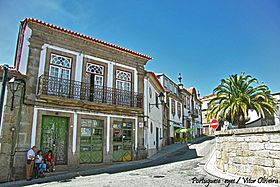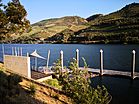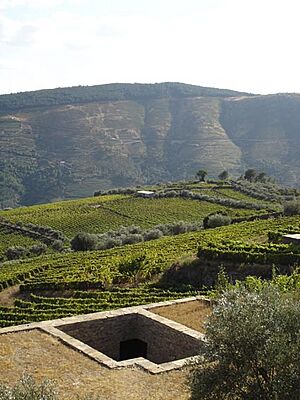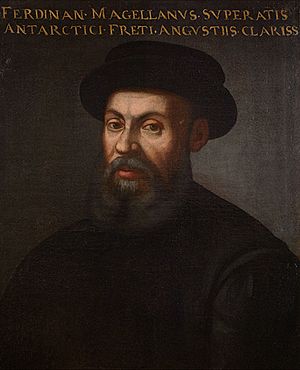Sabrosa facts for kids
Quick facts for kids
Sabrosa
|
|||
|---|---|---|---|
|
Municipality
|
|||
|
|||
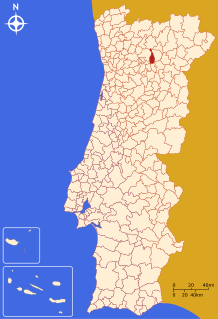 |
|||
| Country | |||
| Region | Norte | ||
| Intermunic. comm. | Douro | ||
| District | Vila Real | ||
| Parishes | 12 | ||
| Area | |||
| • Total | 156.92 km2 (60.59 sq mi) | ||
| Elevation | 544 m (1,785 ft) | ||
| Population
(2011)
|
|||
| • Total | 6,361 | ||
| • Density | 40.537/km2 (104.989/sq mi) | ||
| Time zone | WET/WEST (UTC+0/+1) | ||
| Postal code |
5060
|
||
| Area code | 259 | ||
| Website | http://www.cm-sabrosa.pt | ||
Sabrosa is a town and a municipality located in northern Portugal. It is part of the Vila Real District in the Norte Region. In 2011, about 6,361 people lived here. The municipality covers an area of 156.92 square kilometers. Sabrosa is famous for being the birthplace of the explorer Ferdinand Magellan.
Contents
History of Sabrosa: From Ancient Times to Today

The municipality of Sabrosa was officially created on November 6, 1945. However, people have lived in this area for a very long time. We know this from ancient remains left by different groups.
Early Settlers and Ancient Structures
During the Stone Age, ancient people built special burial sites called dolmens. One example is the Mamoa 1 de Madorras, a large, well-preserved tomb. Later, during the Iron Age, the Castro culture built many stone forts. These forts, like Castro of Sancha, were placed in spots with good views and natural defenses. They were also made stronger with walls and ditches. The Romans later used the Castro of Sabrosa. They left behind coins and a stone carving for their god, Jupiter. A Luso-Roman cemetery was also found in the area.
Sabrosa in the Middle Ages
Most of the towns in Sabrosa began in the Middle Ages. Many of these towns existed even before Portugal became a kingdom in 1143. Some old Christian buildings from this time can still be seen in places like Arcã and Provesende.
Noble Families and Wine Production
After the 1400s, more detailed records show that important noble families lived in the region. One famous family was the House of Pereira, where the explorer Ferdinand Magellan was born. These families built large estates throughout the area.
The region became very successful because of the growing wine industry in the Douro area. In 1756, the Marquess of Pombal created the Companhia Geral da Agricultura das Vinhas do Alto Douro. This company helped improve the production and quality of Douro wines for export. Most of Sabrosa's parishes were part of this special wine region. This made the area very important for Portugal's economy.
On December 14, 2001, UNESCO recognized the Alto Douro Vinhateiro (the Upper Douro Wine Region) as a World Heritage Site. This means it's a very special place that needs to be protected.
Geography: Where is Sabrosa?
|
||||||||||||||||||||||||||||||
The municipality of Sabrosa covers about 180 square kilometers. It is located in the Vila Real District and is part of the Serra do Marão Tourist Region. It shares borders with other municipalities: Vila Pouca and Murça to the north, Alijó to the east, Vila Real and Peso da Régua to the west, and the Douro River to the south.
The land in Sabrosa is shaped by ancient geology. The northern part has granite rocks and pine trees. The southern part has schist rocks, which are perfect for growing vineyards.
Civil Parishes of Sabrosa
Sabrosa is divided into 12 smaller areas called civil parishes (freguesias):
- Celeirós
- Covas do Douro
- Gouvinhas
- Parada de Pinhão
- Paços
- Provesende, Gouvães do Douro e São Cristóvão do Douro
- Sabrosa
- São Lourenço de Ribapinhão
- São Martinho de Antas e Paradela de Guiães
- Souto Maior
- Torre do Pinhão
- Vilarinho de São Romão
Culture and Traditions
Sabrosa is known for its traditional crafts. These include beautiful embroidery, leather tanning, basket-weaving, and carpentry. The region also makes delicious cheeses.
Local Food and Wine
The food in Sabrosa is part of the Trás-os-Montes culture. Some popular dishes include oven-baked goat with rice (Cabrito assado com arroz de forno) and Cozido à portuguesa, a hearty stew. You can also find bola de carne (a savory meat bread) and local sausages. For sweets, there are pão-de-ló, cavacas altas, and cavaquinhas. Of course, the region is famous for its rich Douro wines and Porto wines.
Notable People from Sabrosa
Many important people have come from Sabrosa:
- Ferdinand Magellan (1480–1521): A famous explorer who worked for the King of Spain. He led the first journey to sail from the Atlantic Ocean across the Pacific Ocean. He was killed during a battle in the Philippines.
- Joaquim Pinheiro de Azevedo Leite Pereira (1829–1918): A winemaker from Douro. He helped save the region's vineyards from a plant disease called phylloxera.
- Mariana Coelho (1857–1954): A Portuguese-Brazilian educator, writer, poet, and an early supporter of women's rights in Brazil.
- António Teixeira de Sousa (1857–1917): A doctor and politician. He served as the 54th Prime Minister of Portugal in 1910.
- Adolfo Correia Rocha (1907–1995): Known as Miguel Torga, he was a very respected poet, playwright, and essayist. His works have been translated into many languages.
- Albertina Machado (born 1961): A long-distance runner who competed in the marathon at the 1996 Summer Olympics.
- Vítor Alves (born 1985): A Portuguese football player who has played in over 330 club games.
Sister City
Sabrosa has a special connection with another city:
 Cebu City, Philippines
Cebu City, Philippines
Images for kids
See also
 In Spanish: Sabrosa para niños
In Spanish: Sabrosa para niños


